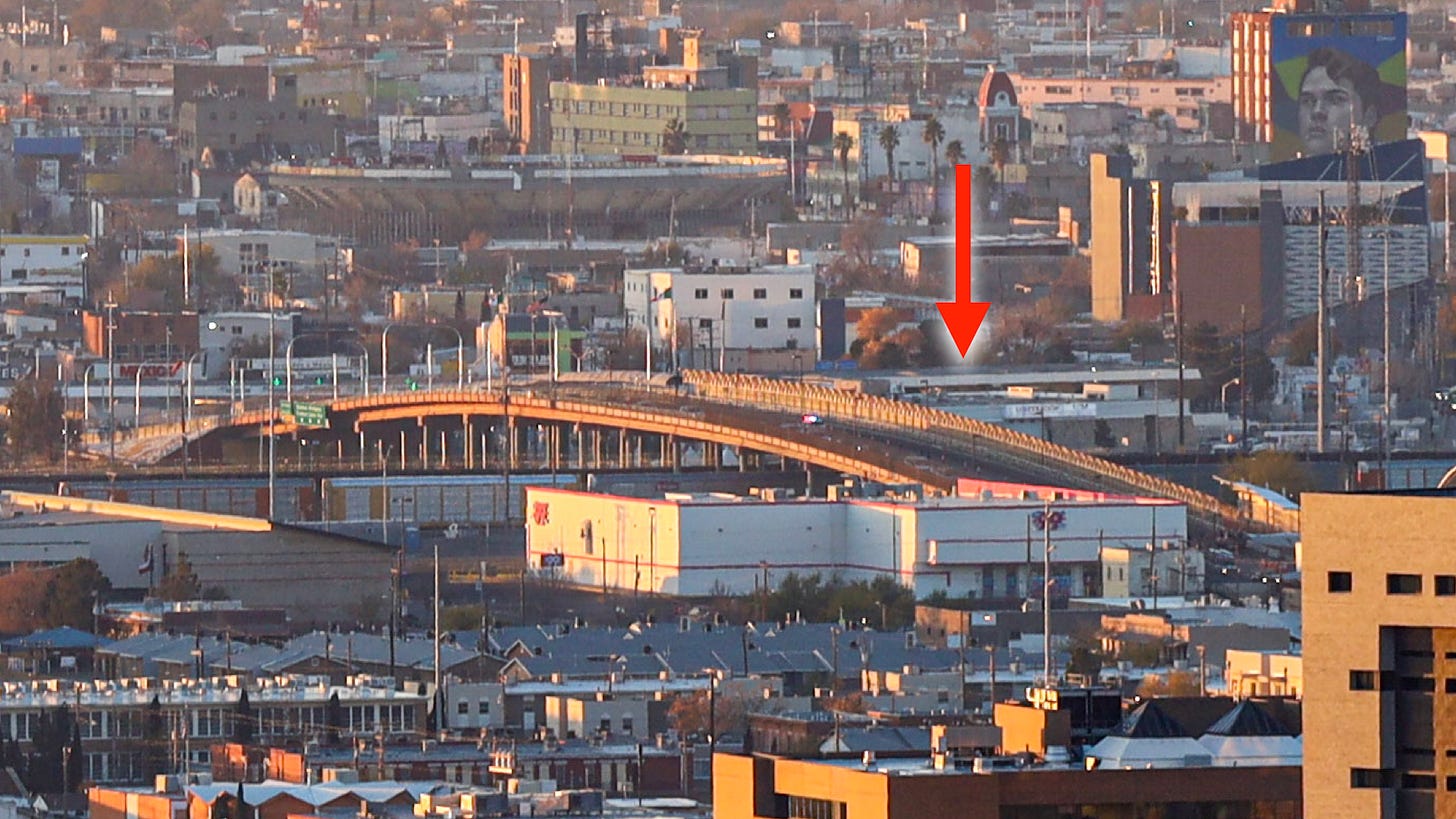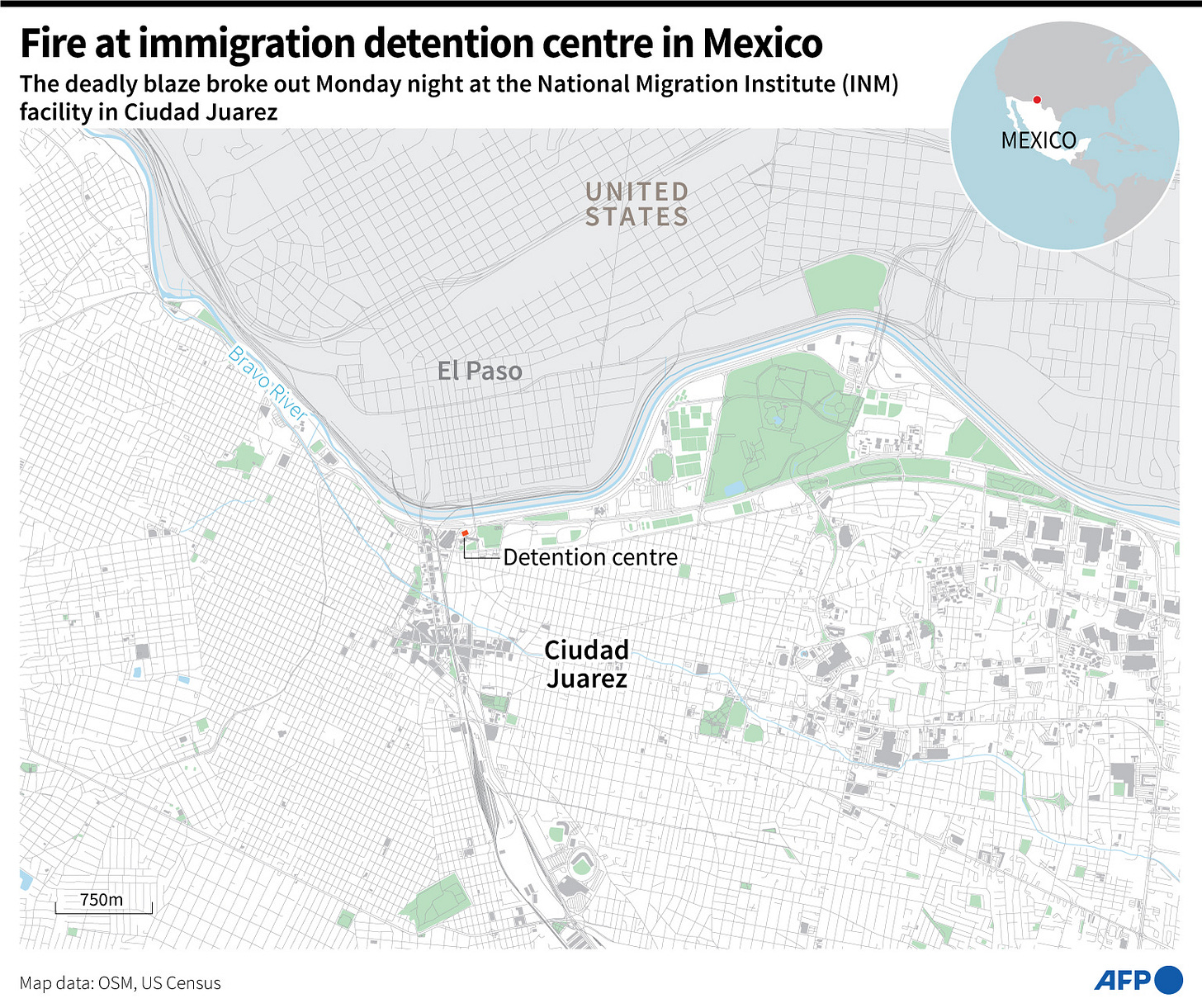Fire at Migrant Detention Facility in Juarez, Mexico, Takes the Lives of 39 People
Mexican government announces investigation and criminal charges, but are the US' and Mexico's immigration policies the real culprit?
Earlier this week in Juarez, Mexico—a city conjoined with El Paso, Texas—a fire broke out at an immigrant holding facility that killed around 40 people inside who could not escape the blaze.
The facility—which is operated by the Instituto Nacional de Migración (INM), Mexico’s main immigration enforcement agency—held migrants who were attempting to reach the United States as well as migrants who had been recently expelled back into Mexico by US Border Patrol.
The facility also held migrants that Mexican authorities had rounded up on the streets of Juarez. I heard of this happening when I was in Juarez in December, but hadn’t seen it myself. The Washington Post reports the story of a young woman, Stefania Arango from Venezuela, who said she had “arrived in the city two weeks ago with her 32-year-old brother, Stefan. He was detained Monday during a sweep by immigration authorities of downtown areas where migrants had been begging, selling candy and washing windshields.”
The best map of the location of the facility comes from Barrons.com here. What’s important to understand is just how close the facility is to the border. It is directly at the base of one of the bridges that goes over the Rio Grande. It also just so happened that I have a picture of that bridge from my recent trip, both a wide shot and a close shot. These were taken from the scenic overlook in El Paso looking south into Mexico. Red arrow points at the INM facility. You can see the facility here on Google Maps.

Details are still emerging, of course, and early accounts of the origins of the fire are still being debated. Mexican President Andrés Manuel López Obrador said that migrants set their mattresses on fire once they learned they would be deported. But a former employee at Mexico’s Human Rights Commission told VICE reporter Emily Green that he was not convinced by this narrative, noting that “authorities take all all migrants' possessions when they are booked, including their shoelaces.”
Other accounts claimed that migrants were protesting overcrowding in the facility and the lack of access to basic drinking water. If true, it wouldn’t be the first time that migrants have protested the conditions of their detention. In October in Tijuana, Venezuelan migrants there also protested their detention, perhaps also after learning they would be deported.
Even though details of the catastrophe are still emerging, immigrant rights advocates stressed the importance of understanding the Juarez detention fire in relationship with the policy climate in which it occurred.
Isa Noyola, the Deputy Director of Mijente, told Truthout, "The fire at the shelter is a devastating tragedy and a reminder of how border and immigration policies are shaping and intensifying a crisis of fear that fuels a greater disparity and loss of human lives.”
Silky Shah, Director of Detention Watch Network, also told Truthout, “This tragedy is the direct result of the United States's immigration system, which has prioritized deterrence, detention, and militarization over humanity at every step. The U.S. and Mexican governments are morally complicit in the abuse and death that people migrating for safety face once they arrive at the Southern border.”
Professor Pedro Gerson (@elpgerson) from California Western School of Law wrote an excellent op ed for Slate that is worth reading in its entirety, but I’ll just emphasize his key argument here: “While the cause of the fire is an open question, the cause of death is not: it was the state.”
To Gerson’s point, a video posted on Twitter by Mexican journalists appears to show guards walking away from the people detained inside behind bars rather than helping them or releasing them.
I hesitate to draw too much from the video until we know the full story, others have already interpreted the video to represent the guards’ personal culpability—an entirely plausible conclusion that may well stand up to further scrutiny. But then this morning, the Specialized Prosecutor for Human Rights of the Attorney General of Mexico announced that they will issue arrest warrants for those who are responsible for the deaths because they failed to act as part of an ongoing investigation into the deaths.
This might be a necessary step to understanding the full story of what happened, but if we take the above critiques of Noyola, Shah, and Gerson seriously, the apparent willingness of the Mexican government to prosecute a few (likely very low ranking people) involved hardly addresses the systemic and binational ethical culpability that both the US and Mexico bear for creating the conditions for this tragedy or the many tragedies to come.
In a previous blog post from 2021 titled “How Our Immigration System Treats Migrants’ Lives as Expendable”, I wrote about the ways in which the state “makes live” (i.e. actively provides support to some) and also “lets die” (i.e. simply withdrawing support or doing nothing to help). The concept behind that post was that migrant death is a chaotic yet predictable outcome of the way that immigration policies are structured.
The fire in Juarez is an enormous tragedy. No one should die over a drink of water or over trying to seek asylum. But the tragedy heartbreakingly illustrates the way that migrants lives are treated as expendable both in design and in practice by our immigration system.
Support public scholarship.
Thank you for reading. If you would like to support public scholarship and receive this newsletter in your inbox, click below to subscribe for free. And if you find this information useful, consider sharing it online or with friends and colleagues.






